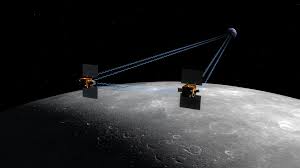GRAIL Mission : NASA

NASA’s GRAIL mission recently unveiled significant differences between the moon’s nearside and farside, attributing them to tidal deformation and varied volcanic activity.
- Gravity Recovery and Interior Laboratory (GRAIL) is a NASA lunar mission launched in 2011.
- It consisted of two robotic spacecraft, Ebb and Flow, which orbited the moon to create the most detailed gravitational map of the lunar surface to date.
- The mission’s primary goal was to measure variations in the moon’s gravitational field, providing critical insights into its internal structure and geological history.
- The GRAIL mission achieved this by precisely measuring the distance between the two spacecraft as they orbited the moon.
- Even tiny changes in this distance, caused by variations in the moon’s gravitational pull, provided data about the moon’s interior composition, crust thickness, and subsurface anomalies.
- This approach has proven crucial for understanding the forces that shaped the moon’s contrasting hemispheres.
- GRAIL discovered that the Moon’s crust was more porous and not as thick as previously supposed.
- It also discovered long linear features called “dikes” that were evidence of the Moon’s expansion by a few kilometres early in its history.
- It unveiled significant differences between the moon’s nearside and farside, attributing them to
- The lunar nearside flexes slightly more than the farside during its elliptical orbit around Earth, a phenomenon known as tidal deformation.
- This difference in flexibility is primarily driven by Earth’s gravitational pull, which exerts a greater influence on the side facing our planet.
- The moon’s nearside was once more volcanically active than the farside with vast plains of basaltic rock known as “mare.”
- This volcanic activity concentrated heat-producing, radioactive elements like thorium and titanium in the nearside mantle, resulting in a significant temperature difference between the two hemispheres, creating a long-term thermal imbalance that has shaped the moon’s geology over billions of years.
- The nearside crust is significantly thinner than the farside crust, allowing magma from the moon’s interior to more easily reach the surface in the past, leading to extensive lava flows.




